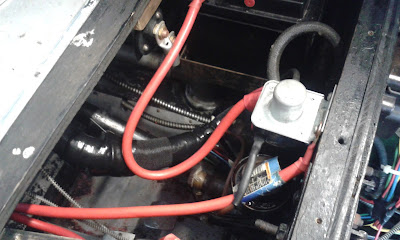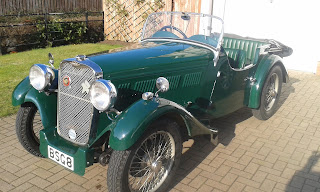My dad was very keen to get as many dials as possible onto the dash. In all, there were nine! This included both a volt meter (in addition to the amp meter) and a vacuum gauge. All very useful, but at the price of everything else being located underneath the dash (ie ignition switch, starter button, lights, choke, horn and indicators). These were therefore all quite difficult to use.
So, first up was the painstaking task of replacing the connector block by soldering the wire connections instead. Never having wielded a soldering iron before, I scoured the web and Youtube for advice, most of which was contradictory or didn't work. For example, it seems you're meant to heat the wires rather than the solder; if I'd persevered with that I'd still be trying to complete the first join! After a lot of trial and error, squinting and contortions, the first job was completed during the Christmas holidays.
 Second job was to put the wires in some sort of loom. Not wanting to disconnect everything, I found on the internet loom material that allows you to insert the wires from the side, after which the loom snaps shut again. Although it works, it's made out of some sort of plastic-type fibre and is really meant for tidying computer cables at the back of a desk, and therefore doesn't look quite right in a car. However, it will do for now.
Second job was to put the wires in some sort of loom. Not wanting to disconnect everything, I found on the internet loom material that allows you to insert the wires from the side, after which the loom snaps shut again. Although it works, it's made out of some sort of plastic-type fibre and is really meant for tidying computer cables at the back of a desk, and therefore doesn't look quite right in a car. However, it will do for now. After tidying up the wires, I could turn my attention to the dashboard. The vacuum gauge and volt meter were superfluous, which released space for the ignition and horn/dip switches.
After tidying up the wires, I could turn my attention to the dashboard. The vacuum gauge and volt meter were superfluous, which released space for the ignition and horn/dip switches. Unfortunately, I found out that the new horn/dip switch is really meant for installation on to a metal panel. I therefore had to cut a relatively thin disc of wood to fit into the hole left by the vacuum gauge. After staining and varnishing, and since it's almost covered up by the horn/dip switch, you hardly notice.
 The new starter button required a hole and the replacement indicator switch could be installed at the far right-hand side. I also meant to put the new wiper switch on the dash, but again hadn't realised that it's really meant for a metal panel and therefore the shank's not long enough for the wooden dashboard.
The new starter button required a hole and the replacement indicator switch could be installed at the far right-hand side. I also meant to put the new wiper switch on the dash, but again hadn't realised that it's really meant for a metal panel and therefore the shank's not long enough for the wooden dashboard. Therefore, for now, the wiper switch and the choke are the only things left tucked under the dashboard, but it's still a big improvement.





